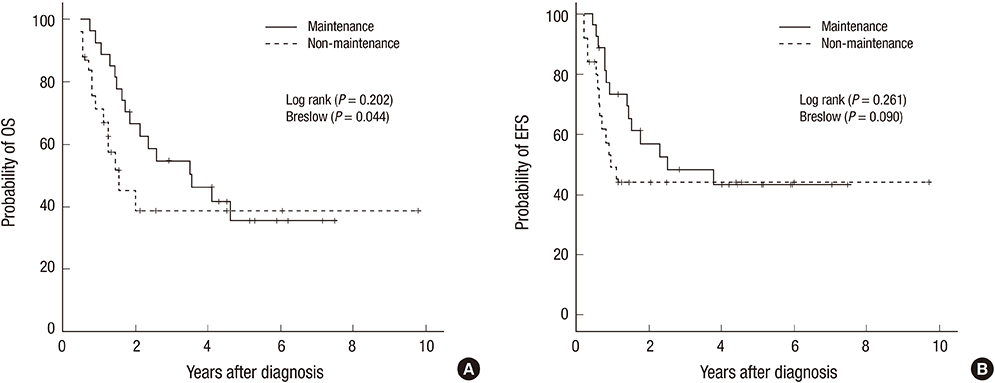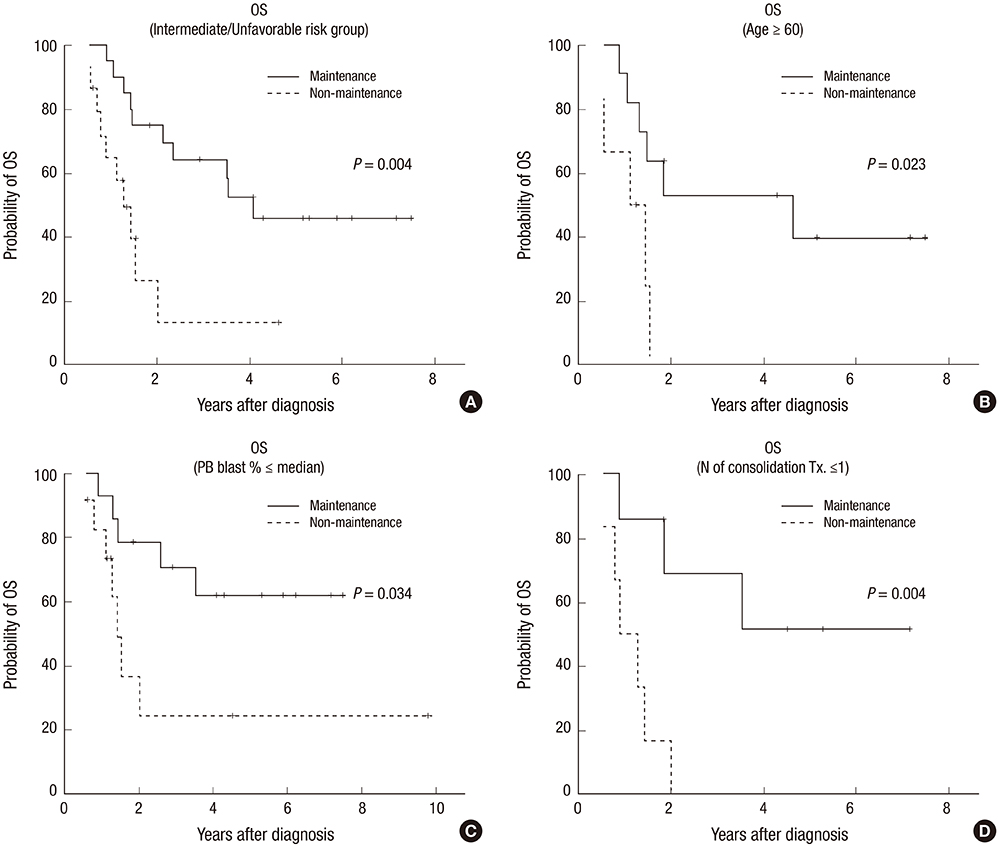J Korean Med Sci.
2015 Oct;30(10):1416-1422. 10.3346/jkms.2015.30.10.1416.
Oral Maintenance Chemotherapy with 6-Mercaptopurine and Methotrexate in Patients with Acute Myeloid Leukemia Ineligible for Transplantation
- Affiliations
-
- 1Department of Hematology-Oncology, Ajou University School of Medicine, Suwon, Korea. jspark65@ajou.ac.kr
- KMID: 2344173
- DOI: http://doi.org/10.3346/jkms.2015.30.10.1416
Abstract
- For decades, maintenance chemotherapy has failed to improve the cure rate or prolong the survival of patients with acute myeloid leukemia (AML), other than those with acute promyelocytic leukemia. Immediately after the first complete remission following consolidation therapy was obtained, oral maintenance chemotherapy (daily 6-mercaptopurine and weekly methotrexate) was given and continued for two years in transplant-ineligible AML patients. Leukemia-free survival (LFS) and overall survival (OS) were studied and compared between these patients and the historical control group who did not receive maintenance therapy. Consecutive 52 transplant-ineligible AML patients were analyzed. Among these patients, 27 received oral maintenance chemotherapy. No significant difference was found in the patients' characteristics between the maintenance and the control groups. The median OS was 43 (95% CI, 19-67) and 19 (95% CI, 8-30) months in the maintenance and the control groups, respectively (P = 0.202). In the multivariate analysis, the presence of maintenance therapy was an independent prognostic factor for better OS (P = 0.021) and LFS (P = 0.024). Clinical benefit from maintenance chemotherapy was remarkable in older patients (> or = 60 yr) (P = 0.035), those with intermediate or unfavorable cytogenetics (P = 0.006), those with initial low blast count in peripheral blood (P = 0.044), and those receiving less than two cycles of consolidation therapy (P = 0.017). Maintenance oral chemotherapy as a post-remission therapy can prolong the survival of patients with AML who are not eligible for transplantation, particularly older patients, those with intermediate or unfavorable cytogenetics, those with initial low blast count, and those receiving less than two cycles of consolidation therapy.
Keyword
MeSH Terms
-
6-Mercaptopurine/*therapeutic use
Adolescent
Adult
Aged
Antimetabolites, Antineoplastic/*therapeutic use
Antineoplastic Combined Chemotherapy Protocols/*therapeutic use
Cytarabine/therapeutic use
Disease-Free Survival
Female
Humans
Idarubicin/therapeutic use
Leukemia, Myeloid, Acute/*drug therapy/mortality
Maintenance Chemotherapy/*methods
Male
Methotrexate/*therapeutic use
Middle Aged
Remission Induction
Treatment Outcome
Young Adult
6-Mercaptopurine
Antimetabolites, Antineoplastic
Cytarabine
Idarubicin
Methotrexate
Figure
Reference
-
1. Deschler B, Lübbert M. Acute myeloid leukemia: epidemiology and etiology. Cancer. 2006; 107:2099–2107.2. Cassileth PA, Harrington DP, Appelbaum FR, Lazarus HM, Rowe JM, Paietta E, Willman C, Hurd DD, Bennett JM, Blume KG, et al. Chemotherapy compared with autologous or allogeneic bone marrow transplantation in the management of acute myeloid leukemia in first remission. N Engl J Med. 1998; 339:1649–1656.3. British Committee for Standards in Haematology. Milligan DW, Grimwade D, Cullis JO, Bond L, Swirsky D, Craddock C, Kell J, Homewood J, Campbell K, McGinley S, et al. Guidelines on the management of acute myeloid leukaemia in adults. Br J Haematol. 2006; 135:450–474.4. Estey EH. Acute myeloid leukemia: 2014 update on risk-stratification and management. Am J Hematol. 2014; 89:1063–1081.5. Mrózek K, Marcucci G, Paschka P, Whitman SP, Bloomfield CD. Clinical relevance of mutations and gene-expression changes in adult acute myeloid leukemia with normal cytogenetics: are we ready for a prognostically prioritized molecular classification? Blood. 2007; 109:431–448.6. Patel JP, Gönen M, Figueroa ME, Fernandez H, Sun Z, Racevskis J, Van Vlierberghe P, Dolgalev I, Thomas S, Aminova O, et al. Prognostic relevance of integrated genetic profiling in acute myeloid leukemia. N Engl J Med. 2012; 366:1079–1089.7. Clift RA, Thomas ED. Seattle Marrow Transplant Team. Follow-up 26 years after treatment for acute myelogenous leukemia. N Engl J Med. 2004; 351:2456–2457.8. Yi HG, Lee MH, Kim CS, Hong J, Park J, Lee JH, Han BR, Kim HY, Zang DY, Kim SH, et al. Gyeonggi/Incheon Branch, The Korean Society of Hematology. Clinical characteristics and treatment outcome of acute myeloid leukemia in elderly patients in Korea: a retrospective analysis. Blood Res. 2014; 49:95–99.9. Burnett AK, Goldstone A, Hills RK, Milligan D, Prentice A, Yin J, Wheatley K, Hunter A, Russell N. Curability of patients with acute myeloid leukemia who did not undergo transplantation in first remission. J Clin Oncol. 2013; 31:1293–1301.10. Preisler H, Davis RB, Kirshner J, Dupre E, Richards F 3rd, Hoagland HC, Kopel S, Levy RN, Carey R, Schulman P, et al. Comparison of three remission induction regimens and two postinduction strategies for the treatment of acute nonlymphocytic leukemia: a cancer and leukemia group B study. Blood. 1987; 69:1441–1449.11. Sauter C, Berchtold W, Fopp M, Gratwohl A, Imbach P, Maurice P, Tschopp L, von Fliedner V, Cavalli F. Acute myelogenous leukaemia: maintenance chemotherapy after early consolidation treatment does not prolong survival. Lancet. 1984; 1:379–382.12. Löwenberg B, Suciu S, Archimbaud E, Haak H, Stryckmans P, de Cataldo R, Dekker AW, Berneman ZN, Thyss A, van der Lelie J, et al. Mitoxantrone versus daunorubicin in induction-consolidation chemotherapy--the value of low-dose cytarabine for maintenance of remission, and an assessment of prognostic factors in acute myeloid leukemia in the elderly: final report. European Organization for the Research and Treatment of Cancer and the Dutch-Belgian Hemato-Oncology Cooperative Hovon Group. J Clin Oncol. 1998; 16:872–881.13. Miyawaki S, Sakamaki H, Ohtake S, Emi N, Yagasaki F, Mitani K, Matsuda S, Kishimoto Y, Miyazaki Y, Asou N, et al. Japan Adult Leukemia Study Group AML 97 Study. A randomized, postremission comparison of four courses of standard-dose consolidation therapy without maintenance therapy versus three courses of standard-dose consolidation with maintenance therapy in adults with acute myeloid leukemia: the Japan Adult Leukemia Study Group AML 97 Study. Cancer. 2005; 104:2726–2734.14. Krug U, Lübbert M, Büchner T. Maintenance therapy in acute myeloid leukemia revisited: will new agents rekindle an old interest? Curr Opin Hematol. 2010; 17:85–90.15. Pui CH, Evans WE. Treatment of acute lymphoblastic leukemia. N Engl J Med. 2006; 354:166–178.16. Fenaux P, Chastang C, Chevret S, Sanz M, Dombret H, Archimbaud E, Fey M, Rayon C, Huguet F, Sotto JJ, et al. The European APL Group. A randomized comparison of all transretinoic acid (ATRA) followed by chemotherapy and ATRA plus chemotherapy and the role of maintenance therapy in newly diagnosed acute promyelocytic leukemia. Blood. 1999; 94:1192–1200.17. Bennett JM, Catovsky D, Daniel MT, Flandrin G, Galton DA, Gralnick HR, Sultan C. French-American-British (FAB) co-operative group. Proposals for the classification of the acute leukaemias. Br J Haematol. 1976; 33:451–458.18. Löwenberg B, Downing JR, Burnett A. Acute myeloid leukemia. N Engl J Med. 1999; 341:1051–1062.19. Büchner T, Urbanitz D, Hiddemann W, Rühl H, Ludwig WD, Fischer J, Aul HC, Vaupel HA, Kuse R, Zeile G, et al. Intensified induction and consolidation with or without maintenance chemotherapy for acute myeloid leukemia (AML): two multicenter studies of the German AML Cooperative Group. J Clin Oncol. 1985; 3:1583–1589.20. Büchner T, Hiddemann W, Berdel WE, Wörmann B, Schoch C, Fonatsch C, Löffler H, Haferlach T, Ludwig WD, Maschmeyer G, et al. German AML Cooperative Group. 6-Thioguanine, cytarabine, and daunorubicin (TAD) and high-dose cytarabine and mitoxantrone (HAM) for induction, TAD for consolidation, and either prolonged maintenance by reduced monthly TAD or TAD-HAM-TAD and one course of intensive consolidation by sequential HAM in adult patients at all ages with de novo acute myeloid leukemia (AML): a randomized trial of the German AML Cooperative Group. J Clin Oncol. 2003; 21:4496–4504.21. Robles C, Kim KM, Oken MM, Bennett JM, Letendre L, Wiernik PH, O'Connell MJ, Cassileth PA. Low-dose cytarabine maintenance therapy vs observation after remission induction in advanced acute myeloid leukemia: an Eastern Cooperative Oncology Group Trial (E5483). Leukemia. 2000; 14:1349–1353.22. Büchner T, Berdel WE, Schoch C, Haferlach T, Serve HL, Kienast J, Schnittger S, Kern W, Tchinda J, Reichle A, et al. Double induction containing either two courses or one course of high-dose cytarabine plus mitoxantrone and postremission therapy by either autologous stem-cell transplantation or by prolonged maintenance for acute myeloid leukemia. J Clin Oncol. 2006; 24:2480–2489.23. Cassileth PA, Lynch E, Hines JD, Oken MM, Mazza JJ, Bennett JM, McGlave PB, Edelstein M, Harrington DP, O'Connell MJ. Varying intensity of postremission therapy in acute myeloid leukemia. Blood. 1992; 79:1924–1930.24. Avvisati G, Lo-Coco F, Paoloni FP, Petti MC, Diverio D, Vignetti M, Latagliata R, Specchia G, Baccarani M, Di Bona E, et al. GIMEMA, AIEOP, and EORTC Cooperative Groups. AIDA 0493 protocol for newly diagnosed acute promyelocytic leukemia: very long-term results and role of maintenance. Blood. 2011; 117:4716–4725.25. Asou N, Kishimoto Y, Kiyoi H, Okada M, Kawai Y, Tsuzuki M, Horikawa K, Matsuda M, Shinagawa K, Kobayashi T, et al. Japan Adult Leukemia Study Group. A randomized study with or without intensified maintenance chemotherapy in patients with acute promyelocytic leukemia who have become negative for PML-RARalpha transcript after consolidation therapy: the Japan Adult Leukemia Study Group (JALSG) APL97 study. Blood. 2007; 110:59–66.26. Nagai S, Takahashi T, Kurokawa M. Risk-adapted maintenance therapy for acute promyelocytic leukemia. J Clin Oncol. 2010; 28:e21. author reply e2-3.27. Karp JE, Smith BD, Gojo I, Lancet JE, Greer J, Klein M, Morris L, Levis MJ, Gore SD, Wright JJ, et al. Phase II trial of tipifarnib as maintenance therapy in first complete remission in adults with acute myelogenous leukemia and poor-risk features. Clin Cancer Res. 2008; 14:3077–3082.28. Baer MR. Is there a role for maintenance therapy in acute myeloid leukaemia? Best Pract Res Clin Haematol. 2009; 22:517–521.
- Full Text Links
- Actions
-
Cited
- CITED
-
- Close
- Share
- Similar articles
-
- Pancreatitis Induced by 6-mercaptopurine and 6-thioguanine in Childhood Acute Lymphoblastic Leukemia
- Severe recurrent nocturnal hypoglycemia during chemotherapy with 6-mercaptopurine in a child with acute lymphoblastic leukemia
- Plasma levels of oral methotrexate in children receiving maintenance chemotherapy for acute lymphocytic leukemia
- Intraparenchymal Myeloid Sarcoma and Subsequent Spinal Myeloid Sarcoma for Acute Myeloblastic Leukemia
- Oral Manifestation and Treatment of Acute Myeloid Leukemia: A Case Report



